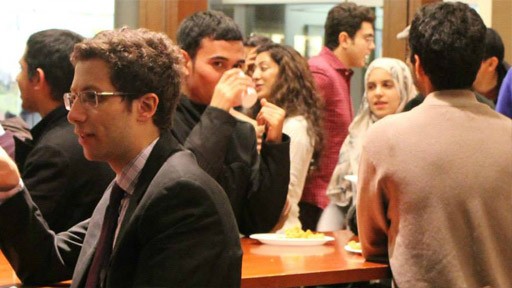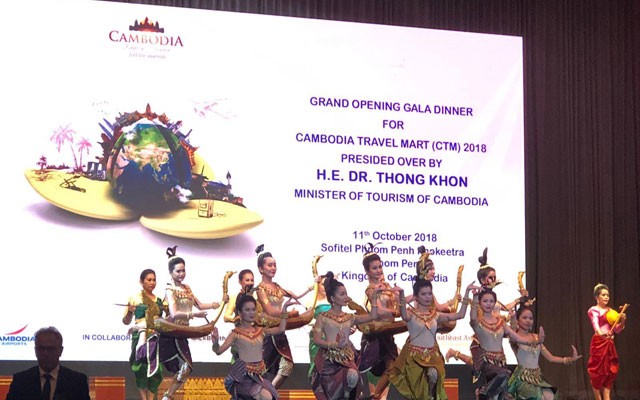Islam in Present
Islam has been in Cambodia in Cambodia for many centuries ago. We also have an inscription in stone, which got from Bak Kheng temple (The name of temple) in the Khmer museum of Cambodia has an Arab's text "لآ اِلَهَ اِلّا اللّهُ مُحَمَّدٌ رَسُوُل اللّهِ" (THERE IS NO ALLAH BUT ALLAH, MUHAMMAD IS THE MESSENGER OF ALLAH). Khmer Islam has been on gold territory of Cambodia from previous time to nowadays be full of freedom in both their job, their religion, and their politic in religious cooperation to respect their tradition and their right to up to Cambodia's law. We have a half of million Islam people has been living at their areas of most 24 provinces always have own mosque (Masjid) to pray (Solat), to traditional obeying, religious obeying, marriage, ceremonies, religious meeting, traditional announcement, moral principle, and school to.There was been normally to be free by no banning from policeman.
Political Attending was comfortable welcome to push and encourage in carry out of development and protection of beloved country. Nowadays, Islam was noticed to increase success. Islam, which got rank 2 of other large religions next to Buddhism. By these reasons, Islam was called "Khmer Islam" because the large amount of Islamism is Cham nationality and another part is Khmer people to obey Islam. In this meaning, government of Cambodia gave right to religious cooperation, no banning. Moreover, he has helped to announced about Islam and Islamism in Cambodia to human on the world and also let them know about their culture and tradition too. The government of Cambodia also expressed one's attention and he didn't look down on these people. He always has given a value Islam human in both Cambodia and around the world.
MUSLIM COMMUNITY
The Muslim community in Cambodia differs from mainstream Khmer along both ethnic and religious lines. While the vast majority of Khmer are Buddhist, the Muslim community follows Islam and derives from two principal groups. The Chvea arrived in Cambodia first in the 14th century from the Malay Peninsula and Indonesia, and rationally occupied the southern part of the country.69 In the 15th century, the Cham migrated from Champa, a kingdom formerly located in the south of Vietnam.70 While some scholars have suggested that inter-marriage between the two groups has served to forge a singular Muslim community,71 others identify two dissect groups. During independence in 1953, King Sihanouk sought to envelop all minority groups within the Cambodian on by adding 'Khmer' to their name.72 To Muslims, he gave thetle 'Khmer Islam', in order to group the Cham and Chvea together under a single Khmer identity. Some research has indicated that the term 'Khmer Islam' has been more widely accepted among the Chvea than the Cham.73 Adding to the complexity of nomenclature, some researchers use the term 'Cham' inclusively to refer to both Cham and Chvea alike. 74 Where the groups are diff reenacted in the literature and by individuals themselves, the terms they employ are used in this report.
IMAM SANN COMMUNITY
Imam Sann community is the smallest Muslim group in Cambodia. It is comprised of approximately 38,000 members. They live mostly in Kampong Tralach district of KampongChhnang province, but can also be found in provinces such as Kandal, Pursat, Battambang and Kampot. According to the group's mufti, Kai Team, there are currently 53 mosques and suravs for the Imam Sann community in Cambodia. This group is considered by other groups as less orthodox in their practice of Islam as they only pray one time in seven days. The manner of their prayers, Islamic practices and everyday costumes are also different from other groups. For example, they do not wash their face when they pray. The men do not need to keep a beard. The men's headscarf (or Khimar) is not the cap-like, wrap-around style used by other Cambodian Muslims. Some men use the Khmer Kramar as headscarf. Indeed, one can see no specific headscarf guideline among the men. Other men wear Khmer-like white scarf around, but not covering, their heads. A few men do wear Khimar. Old men wear simple, white, long-sleeved shirts and long pants. Without their headscarves, they look just like Buddhist priests. During the Mawlid ceremony, single women wear green robes while married women wear black robes. However, they do not cover their heads or faces in any Islamic fashion.
The Imam Sann group follows the religious practices of a mysterious, yet famous, Imam Sannwho was recognized by a Cambodian King. He was a close counsel to the King and the King gave him a site at the foot of Oudong mountain to build a mosque. Some Muslims say that Imam Sannknew magic, which indicates the influence of Hinduism. Imam Sann's way of practicing Islam was distinct and strong enough that it commands a devoted group of followers. Today this group is in danger of assimilation into the more orthodox majority Sunni sect. Presumably the Imam Sanngroup speaks and writes the Cham language more proficiently than other groups. They also believe themselves to be the protectors of the original Cham cultural heritage. According to Kai Team, their number is decreasing. Charity organizations offer funding for community development, on condition that the Imam Sann follows the organization's observation of Islam--for example, by praying five times a day. Some Muslims believe that Imam Sann religious practices reflect a lack of understanding of Islam. Osman Hassan, who is a secretary of state of the ministry of labor, believes that once this group understands that they are different from other Muslims in the "world," they will change. But Osman Hassan does not want to force change or provide aid conditioned on change. He wants to preserve a dialogue. But Imam Sann Muslims believe that they are already close to Allah, so there is no need to pray five times a day.
When you subscribe to the blog, we will send you an e-mail when there are new updates on the site so you wouldn't miss them.


